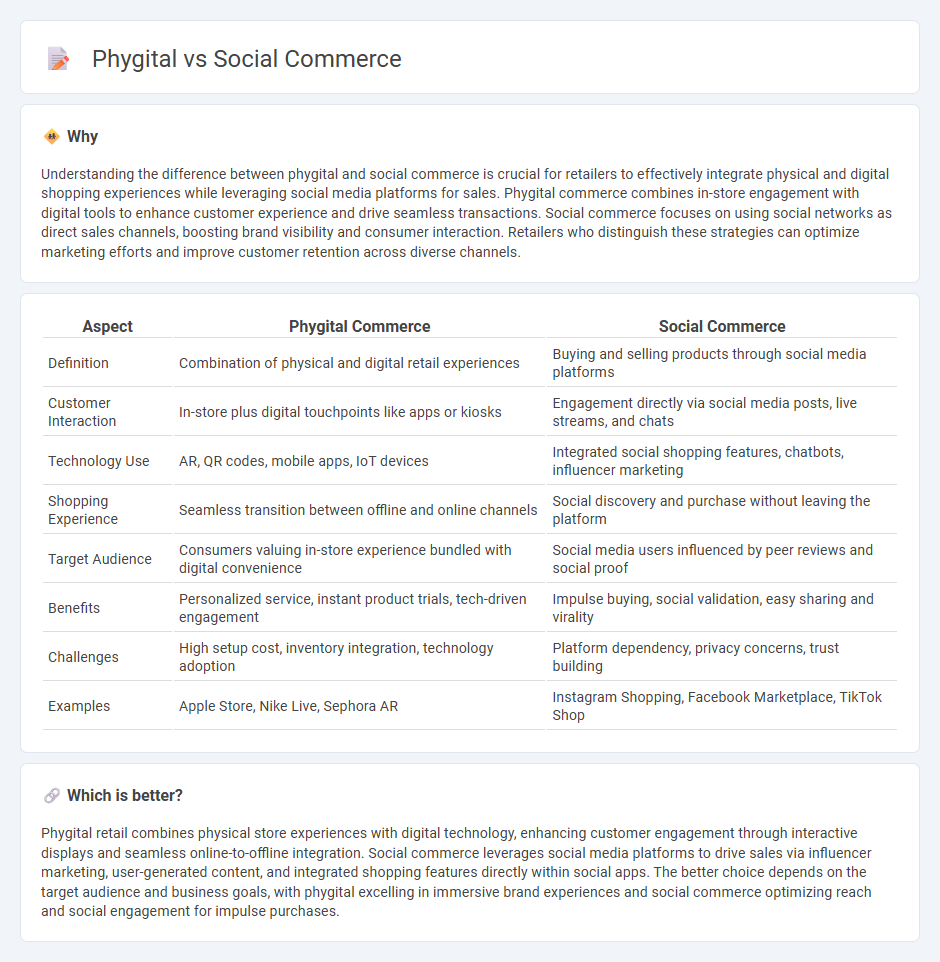
Phygital retail integrates physical stores with digital experiences to create seamless customer interactions, enhancing engagement through technologies like AR, IoT, and mobile apps. Social commerce leverages social media platforms to enable direct purchasing and community-driven shopping, driving sales via influencer marketing and user-generated content. Explore how these innovative retail strategies transform consumer behavior and business growth.
Why it is important
Understanding the difference between phygital and social commerce is crucial for retailers to effectively integrate physical and digital shopping experiences while leveraging social media platforms for sales. Phygital commerce combines in-store engagement with digital tools to enhance customer experience and drive seamless transactions. Social commerce focuses on using social networks as direct sales channels, boosting brand visibility and consumer interaction. Retailers who distinguish these strategies can optimize marketing efforts and improve customer retention across diverse channels.
Comparison Table
| Aspect | Phygital Commerce | Social Commerce |
|---|---|---|
| Definition | Combination of physical and digital retail experiences | Buying and selling products through social media platforms |
| Customer Interaction | In-store plus digital touchpoints like apps or kiosks | Engagement directly via social media posts, live streams, and chats |
| Technology Use | AR, QR codes, mobile apps, IoT devices | Integrated social shopping features, chatbots, influencer marketing |
| Shopping Experience | Seamless transition between offline and online channels | Social discovery and purchase without leaving the platform |
| Target Audience | Consumers valuing in-store experience bundled with digital convenience | Social media users influenced by peer reviews and social proof |
| Benefits | Personalized service, instant product trials, tech-driven engagement | Impulse buying, social validation, easy sharing and virality |
| Challenges | High setup cost, inventory integration, technology adoption | Platform dependency, privacy concerns, trust building |
| Examples | Apple Store, Nike Live, Sephora AR | Instagram Shopping, Facebook Marketplace, TikTok Shop |
Which is better?
Phygital retail combines physical store experiences with digital technology, enhancing customer engagement through interactive displays and seamless online-to-offline integration. Social commerce leverages social media platforms to drive sales via influencer marketing, user-generated content, and integrated shopping features directly within social apps. The better choice depends on the target audience and business goals, with phygital excelling in immersive brand experiences and social commerce optimizing reach and social engagement for impulse purchases.
Connection
Phygital retail merges physical and digital shopping experiences to create seamless customer journeys, driving higher engagement and conversion rates. Social commerce leverages social media platforms to directly sell products, integrating interactive content and peer influence to boost sales. Together, phygital strategies enhance social commerce by enabling real-time, interactive buying experiences that blend online convenience with in-store immediacy.
Key Terms
**Social Commerce:**
Social commerce leverages social media platforms like Instagram, Facebook, and TikTok to enable seamless in-app purchasing experiences, integrating user-generated content, reviews, and influencer endorsements to boost trust and drive sales. This approach capitalizes on real-time engagement, social proof, and targeted advertising to enhance conversion rates and build community around brands. Explore the latest trends and best practices in social commerce to optimize your digital retail strategy.
Shoppable Posts
Shoppable posts integrate social commerce by enabling users to directly purchase products within social media platforms like Instagram and Facebook, streamlining the buyer journey. Phygital experiences blend physical retail with digital interactions, often using in-store kiosks or augmented reality to enhance engagement and drive sales. Explore deeper insights on how shoppable posts revolutionize retail engagement and merge online-offline commerce.
Influencer Marketing
Social commerce leverages influencer marketing by enabling seamless product discovery and purchase directly within social media platforms, enhancing real-time consumer engagement through authentic influencer endorsements. Phygital influencer marketing combines physical retail experiences with digital interactions, using influencers to drive foot traffic and create immersive brand connections via augmented reality and interactive in-store events. Explore how integrating influencer strategies in both social commerce and phygital environments can maximize brand reach and customer loyalty.
Source and External Links
Social commerce - Wikipedia - Social commerce is the use of social networks in e-commerce transactions, allowing customers to browse and purchase products without leaving social media platforms.
What is social commerce? - TechTarget - Social commerce uses social media platforms like Facebook, Instagram, TikTok, and Pinterest to enable direct product sales by combining marketing, customer interaction, and seamless checkout within these networks.
Social Commerce 101: Examples, Platforms & Tips - Square - Social commerce allows businesses to create seamless shopping experiences by selling products directly through social media profiles, reducing friction and integrating community engagement with the purchase process.
 dowidth.com
dowidth.com